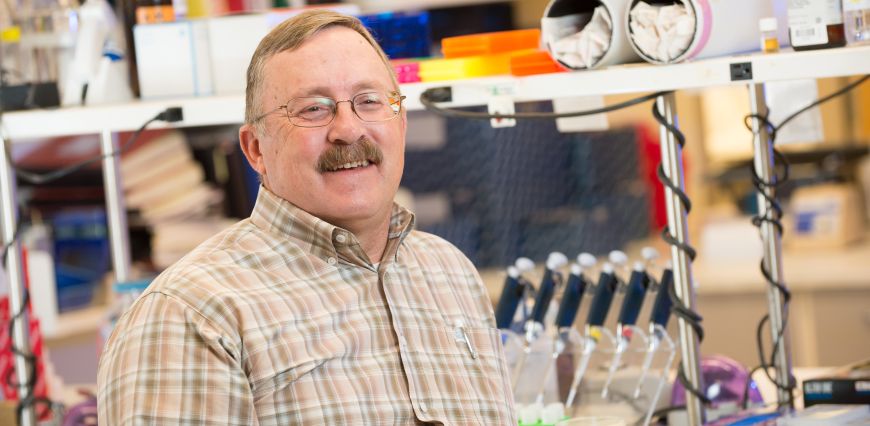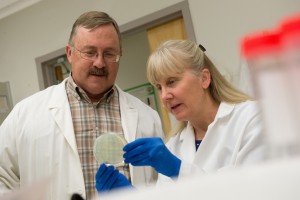
Reducing health problems for many babies with low birth weights begins with better understanding the physiological bonds between mother and child, starting with pregnancy development and function of the placenta, says Russ Anthony, a longtime Colorado State University reproductive scientist.
“We hope to unlock the key factors that drive pregnancy complications,” Anthony, the Hill Professor of Animal Biotechnology with CSU’s Animal Reproduction and Biotechnology Laboratory (ARBL), said of his work.
Translational research
Anthony studies pregnancy development in sheep to better understand pregnancy in people – a form of translational research gaining attention for the important insights it provides human medicine. Last fall, Anthony established the Front Range Pregnancy Consortium, which brings together reproductive scientists and physicians from CSU, the University of Wyoming and the University of Colorado Anschutz Medical Campus to discuss pregnancy research, shared resources and collaborations.
He also leads the Healthy Baby, Healthy Mother research group, formed in 2013 to help focus and emphasize pregnancy-related studies in ARBL, a Colorado State Program of Research and Scholarly Excellence. Other faculty members in the group are Thomas Hansen, Jason Bruemmer, Jerry Bouma, Quinton Winger, Hyungchul Han, and Milt Thomas.
“My research has always focused on pregnancy because I’m fascinated by all of the things that have to happen for a normal outcome at birth,” said Anthony, who has worked for 30 years in the field.
Promoting health from birth through adulthood
Much of his work centers on fetal nutrition and intrauterine growth restriction (IUGR), or the poor growth of a fetus during pregnancy. IUGR begins in the womb and often results in babies with low birth weights, sometimes triggering health complications that cascade through an individual’s lifetime.

IUGR affects an estimated 6 percent to 10 percent of babies born in the United States, with a much higher incidence in developing countries. The condition is the second-leading cause of infant death behind prematurity, which itself often results from IUGR, Anthony noted. Evidence shows that infants born with IUGR later develop higher rates of disease, including coronary heart disease, type-2 diabetes, hypertension and stroke.
Anthony seeks to address these problems – and ultimately to pave the way to treatment and prevention – by studying pregnancy development and placental function.
He is working to understand the underlying mechanisms of IUGR with the long-term goal of developing methods of intervention; he looks to the placenta, and its delivery of nutrients and oxygen to the fetus, for clues. “Placental insufficiency” is the term used when this transport is inadequate.
“These studies are important because, in addition to causing IUGR, placental insufficiency and other complications of the placenta have the potential to result in health issues for the mother,” said Quinton Winger, an associate professor in the Department of Biomedical Sciences who often collaborates with Anthony.
Early research findings show promise
Early research findings from his team suggest that placental lactogen, a hormone produced only by the placenta and discovered in humans 50 years ago, could be a key to promoting nutrient transfer from mother to the fetus, Anthony said.
Using technology developed in Anthony’s laboratory, CSU researchers have demonstrated that a 50 percent reduction in sheep placental lactogen production resulted in a 50 percent reduction in placental size and a 30 percent reduction in fetal size near-term.
“This is exciting because we can finally assess the true function of a hormone that we have known about for a long time,” Anthony said.
Sheep have proved an ideal animal model for studying pregnancy, Anthony said, because scientists know more about placental nutrient transfer and placental metabolism in the sheep than in any other species. In addition, nutrient transfer and utilization are very similar in sheep and human pregnancies. These dynamics present enormous opportunity for relevant in vivo studies, he said.
The Healthy Baby, Healthy Mother group also is in the early stages of investigating the role of specific genes in the development and function of the placenta, as well as links to IUGR.
“If scientists and clinicians can understand the causes of placental dysfunction, we will be more informed to develop treatment and prevention plans in the future,” Bouma noted.
Hansen, ARBL director, praised Anthony for mentoring younger faculty and graduate students and for developing team approaches to solve critical problems in reproduction.
“There is a lot of excitement in our research group about the techniques that Dr. Anthony has perfected,” Winger said, adding that investigators in the Healthy Baby, Healthy Mother group are eager to further their studies of placental genes. “What we learn will help lead to improved pregnancy outcomes in the future.”